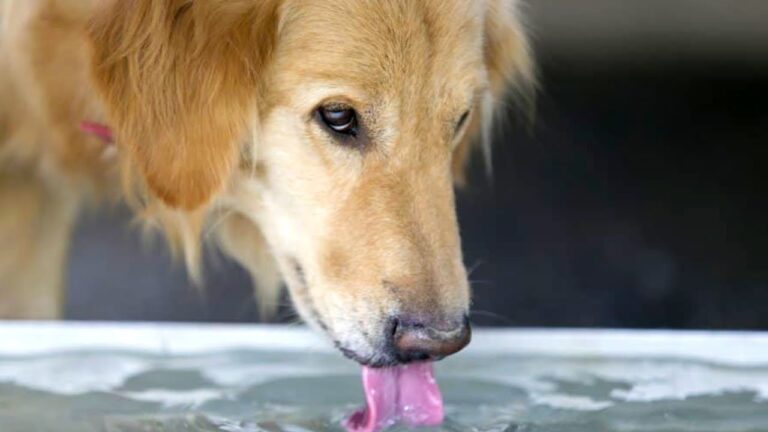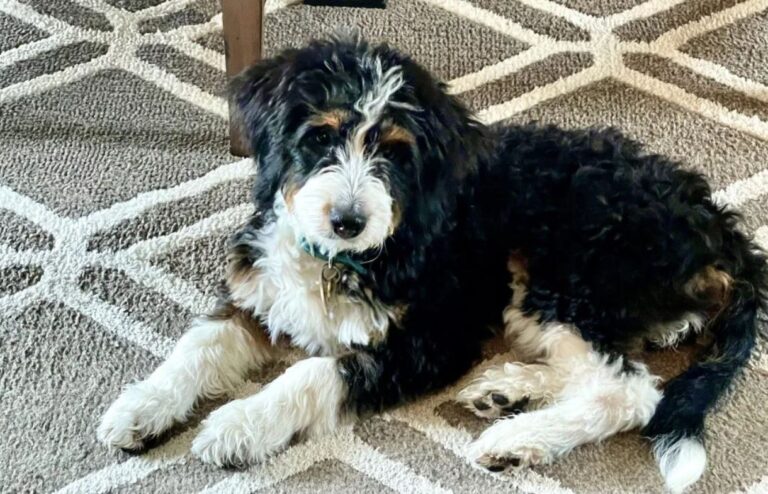What Are The Black Spots Or Gunks On My Dog’s Nipples? (Discolored Dog Nipples)

Perhaps, you were about to give your fur baby a soothing belly rub, just to notice some black spots, gunks, or crust on or around her nipples. This is a common and natural occurrence and does not necessarily mean another trip to the vet.
So, what exactly causes these discolorations to appear on your dog’s nipples?
A common culprit of black spots or gunks in your dog’s nipples is the accumulation of dead skin cells, dirt, and debris when your dog’s skin is too oily or sticky from sebum, milk, or her pup’s saliva. Blackening of your dog’s nipples can also be due to false/true pregnancy, inverted nipples, hyperpigmentation, parasites, and dog acne. Serious conditions like mastitis and mammary gland tumors are no exception.
In the following sections, we will delve deeper into each possible cause, explore the symptoms to watch out for and provide practical tips on how to address and prevent these issues.
What Are The Black Spots or Dots On My Dog’s Nipples?
Observing black spots or dots on your dog’s nipples can be quite alarming. These changes in your dog’s skin coloration can indicate a variety of conditions, and it’s crucial to understand what they may represent:
- Dead Skin, Dirt & Debris:
Just like humans, dogs naturally shed dead skin cells. If these cells are not regularly groomed or washed away, they can accumulate on the skin’s surface. This accumulation can darken and dry over time, leading to a formation of black dots or crust.
Similarly, dogs that love outdoor activities can accumulate dirt or debris on their skin. If not cleaned regularly, this dirt can combine with sebum and dead skin cells, creating black spots. This can be particularly noticeable in areas like the nipples, where the skin is folded and can easily trap these substances.
- Canine Acne:
Believe it or not, dogs can get acne, too. This condition in dogs, much like in humans, can lead to the formation of blackheads or dark spots. These blemishes can appear anywhere on the body, including the nipples. Factors contributing to canine acne can include hormonal changes, certain breeds’ genetic predispositions, trauma to the skin, or stress. If your dog’s black spots resemble pimples or blackheads, canine acne could be the cause.
- Hyperpigmentation or Sunburn:
Dogs, particularly those with lighter coats or thinly coated areas, are susceptible to sunburn. Extended sun exposure can lead to skin damage and a condition called hyperpigmentation. This condition is characterized by the darkening of the skin due to an increase in melanin, the pigment that gives color to the skin, hair, and eyes. Consequently, if your dog spends a lot of time outdoors, sunburn or hyperpigmentation might be causing black spots on their nipples.
- Mastitis:
Mastitis is an infection of the mammary glands typically seen in lactating dogs but can occur in non-lactating dogs as well. It’s caused by bacteria that invade the mammary gland, often during nursing. This condition can lead to inflammation, redness, swelling, and discomfort. In more severe or untreated cases, mastitis may cause the affected tissue to become necrotic, forming black spots or dots on the nipples.
- Pregnancy Or Pseudopregnancy:
Hormonal changes related to pregnancy or pseudopregnancy can also affect your dog’s nipples. During these periods, it’s common for the nipples to enlarge, darken, and even develop black spots. Pseudopregnancy, also known as a false pregnancy, can occur after a female dog’s heat cycle and mimic the signs of actual pregnancy, including changes in the nipples.
While some of these causes are relatively benign, others could indicate a serious condition. Therefore, it’s essential to monitor any changes to your dog’s nipples and consult with your veterinarian if you notice persistent or worrying signs. In many cases, early detection and treatment can significantly improve the prognosis and overall health of your dog.
What Does The Black Gunk or Crust On My Dog’s Nipples Mean?
If you’re noticing a black gunk or crust on your dog’s nipples, it’s important to know that this could be indicative of several things:
- Overproduction Of Sebum: The skin of dogs, like humans, contains sebaceous glands that secrete an oily substance known as sebum. This substance helps protect and moisturize the skin. However, in some cases, these glands can produce sebum excessively, leading to a buildup that appears as a black waxy, gunky substance on your dog’s nipples. While this overproduction can be harmless, it may also indicate underlying health issues, such as hormonal imbalances or skin infections.
- Inverted Nipples: In some dogs, especially older or overweight ones, the nipples may become inverted or “tucked in.” This can lead to a buildup of skin cells, sebum, and possibly bacteria, causing a black, crusty appearance.
- Flea Dirt: Fleas are common parasites that can infest dogs. They feed on your dog’s blood and leave behind what is known as ‘flea dirt‘ or their excrement. Flea dirt consists of digested blood, which can look like small black specks or a black, crumbly substance. If your dog has fleas, they can leave behind this flea dirt on your dog’s skin, including around the nipples.
- Skin Infections or Dermatitis: Bacterial or yeast infections can cause a crusty, black substance to form on your dog’s skin. These infections can occur due to a number of reasons, including a weakened immune system, allergy, or a break in the skin.
- Hormonal Changes: Sometimes, black gunk or crusty substance around your dog’s nipples could be a result of hormonal changes, particularly in pregnant or pseudopregnant dogs. Hormonal fluctuations can lead to changes in skin color and texture.
Why are there Blackheads On My Dog’s Nipples? (Canine Acne)
Blackheads, medically known as comedones, can indeed form on a dog’s nipples. They are caused by a blockage in the hair follicles by sebum (the oily substance produced by the skin) and dead skin cells. While dogs don’t get acne as frequently as humans do, they can still experience a form of it. This condition is called canine acne.
Canine acne typically manifests as small bumps or blackheads and can occur anywhere on a dog’s body, though it’s most commonly found on the face. In some cases, however, these blemishes can also develop on the nipples. Factors that contribute to the development of blackheads or canine acne on your dog’s nipples include:
- Genetic Predisposition: Certain breeds, particularly those with short coats like Boxers, Bulldogs, and Rottweilers, are more prone to canine acne and might develop blackheads on their nipples.
- Hormonal Changes: Just like in humans, hormonal fluctuations in dogs, especially during puberty, can lead to the overproduction of sebum. This excess sebum can clog the pores, leading to the formation of blackheads.
- Poor Hygiene or Lack of Grooming: Accumulated dirt, debris, and dead skin cells can block the hair follicles, leading to blackheads. Regular bathing and grooming can help prevent this buildup and keep your dog’s skin clean and healthy.
- Trauma or Friction: Damage to hair follicles can also lead to the formation of blackheads. This can occur due to constant friction from certain types of clothing or harnesses, or even from your dog’s habit of lying on hard surfaces.
- Underlying Health Conditions: Certain underlying health conditions, such as Cushing’s disease or hypothyroidism, can lead to skin issues including the development of blackheads.
If you notice blackheads on your dog’s nipples, it’s important not to try to squeeze or pop them, as this can lead to an infection or further irritation. A veterinarian should be consulted for proper diagnosis and treatment, which may include topical therapies or medicated shampoos. Regular grooming and a balanced diet can also contribute to your dog’s overall skin health and help prevent future occurrences of canine acne.
What To Do If Your Dog Has Black Spots Or Gunk On Her Nipples
If you notice black spots or gunk on your dog’s nipples, it’s important to act prudently to ensure your pet’s health and comfort. Here are the steps you should consider taking:
- Assess the Situation: Observe your dog’s behavior and overall health. Is she showing any signs of discomfort, itching, or pain? Are there any changes in her eating or sleeping habits? Are the black spots spreading or changing in size? Is the gunk persistent even after cleaning? This information can help you better understand the severity of the situation and provide valuable insights to your vet.
- Gentle Cleaning: If the black spots seem to be dirt or debris, you can try gently cleaning the area. Use a soft cloth dipped in warm water to wipe away the gunk. Scrub gently to avoid irritation. It’s also best to avoid using any chemicals or soaps unless recommended by your vet.
- Monitor Changes: After cleaning, continue to keep an eye on the area. If the spots or gunk return quickly, this could indicate a more significant issue, such as a skin infection or hormonal imbalance.
- Flea Check: If your dog has been scratching a lot, it’s worth checking for fleas. The black gunk could be ‘flea dirt,’ which is a polite term for flea feces, consisting of digested blood.
- Contact Your Vet: If the spots or gunk persist, or if your dog seems uncomfortable, it’s time to contact your vet. Try to provide them with as much information as possible about what you’ve observed. They can give you advice over the phone and will likely ask you to bring your dog in for an examination if necessary.
- Follow Vet’s Instructions: Your vet will likely carry out a physical examination and may also run some tests to determine the cause of the black spots or gunk. Be sure to follow their advice and treatment plan closely. This may involve applying topical treatments, administering medications, adjusting your dog’s diet, or changing your grooming routine.
The most important thing is to not panic. While black spots or gunk on your dog’s nipples can sometimes indicate a health issue, in many cases, it’s something benign or easily treatable. Your vet is the best resource to diagnose and guide treatment for your furry friend’s condition.
How To Treat Black or Crusty Dog Nipples
Treating black or crusty nipples on a dog often depends on the underlying cause. Remember, it’s essential to consult with a veterinarian if you notice black or crusty spots on your dog’s nipples. Regardless, here are some general guidelines on how to address the issue:
- Maintain Good Hygiene: Regular bathing can help remove accumulated dirt, debris, and dead skin cells that could be causing the black or crusty-looking nipples. Use dog-appropriate shampoo and warm water, gently cleaning the affected areas. Be sure not to scrub too hard, as this could irritate this area of your dog’s skin. Regular grooming can also help keep your dog’s skin and coat clean, reducing the chance of skin issues.
- Topical Treatments: Depending on the cause, your vet might recommend a topical treatment. For instance, if your dog has canine acne, a vet-prescribed medicated shampoo, lotion, or gel could help clear up the issue. These products often contain ingredients like benzoyl peroxide or chlorhexidine, which can help treat bacterial infections and reduce inflammation.
- Oral Medications: In some cases, your vet might prescribe oral medications. This could include antibiotics for a bacterial infection or antifungal medications for a yeast infection.
- Parasite Control: If the issue is due to fleas or other parasites, appropriate flea and tick control measures will be necessary. This can involve using vet-approved topical treatments, oral medications, or special collars.
- Surgical Intervention: In rare cases where the crustiness is due to a tumor or severe infection, surgical intervention may be required. Your vet will guide you through the options and procedures if this is the case.
When To See The Vet When There Are Black Spots or Gunk On Your Dog’s Nipples?
Understanding when to seek veterinary attention when observing black spots or gunk on your dog’s nipples is crucial for maintaining your pet’s health. Here are more detailed situations that warrant a trip to the vet:
- Persistent Discoloration or Buildup: If the black spots or gunk persist on your dog’s nipples, even after consistent gentle cleaning and improved hygiene practices, it’s time to consult your vet. Persistent signs can indicate an underlying issue that requires treatment, such as a bacterial or yeast infection, a hormonal imbalance, or even a dermatological condition.
- Painful or Swollen Nipples: A dog’s nipples should not typically be painful or swollen. If you notice your pet showing signs of discomfort, such as wincing when you touch the area, or if the nipples seem enlarged, these could be signs of an issue like mastitis, dermatitis, or a tumor. An immediate vet visit is necessary to prevent complications and alleviate discomfort.
- Associated Symptoms: Other signs accompanying the black spots or gunk also warrant attention. These can include redness, warmth around the nipple area, unusual discharge, or a foul odor. The presence of these symptoms can signify an infection or inflammation that needs to be addressed quickly to prevent systemic spread.
- Changes in Behavior: Behavioral changes in your dog like a loss of appetite, lethargy, an increase in sleep, excessive licking or scratching at the nipple area, or signs of general discomfort are signals that there’s something amiss. These behaviors can point to underlying pain or illness that needs veterinary intervention.
- Unexplained Weight Loss: If your dog is losing weight without a change in diet or exercise, this could indicate a serious underlying health condition. Certain metabolic disorders, cancers, and systemic diseases can present with weight loss and skin changes.
- Failure to Nurse Puppies: If you have a nursing mother dog that develops black spots or gunk on her nipples and refuses to nurse her puppies, or if the puppies are not gaining weight and thriving, this could indicate mastitis or other health issues. Mastitis, a breast infection, can be life-threatening if left untreated and can also harm the puppies.
- Black Spots In Other Parts Of Their Body: If black spots or discolored skin isn’t limited to your dog’s nipples but is also appearing on other parts of their body, this should be checked by a vet. Systemic skin conditions, hormonal disorders, or even serious diseases like cancer can present with these symptoms.
Why Are There Black Scabs On My Dog’s Nipples?
Black scabs on your dog’s nipples could indicate a number of different health issues. Let’s explore some potential causes:
- Parasitic Infestation: Parasites such as fleas or mites can cause skin irritation, leading to scratching and eventually the formation of scabs. These parasites often leave behind waste products called ‘flea dirt’, which appear as black specks on the skin. Infestations can cause severe discomfort and skin infections if left untreated, so veterinary intervention is necessary.
- Mastitis: This is an infection of the mammary glands often seen in nursing dogs. It causes inflammation, pain, swelling, and sometimes the formation of black scabs on and around the nipples. Affected dogs may also show systemic signs of illness, such as lethargy and fever. Treatment often involves antibiotics and sometimes surgical intervention.
- Mammary Tumors: A tumor of the mammary gland can manifest as a mass or swelling around the nipple, which can ulcerate and form a scab. These tumors can range from benign to malignant (cancerous) and often require surgical removal. Regular vet checks can help detect these tumors early.
- Yeast Dermatitis: Yeast is a type of fungus that normally lives on your dog’s skin without causing problems. However, if your dog’s immune system is compromised, or if the skin is damaged or excessively moist, yeast overgrowth can occur, leading to a condition known as yeast dermatitis. This can cause itchy, red skin, and may lead to the formation of black scabs over time.
- Allergic Reaction: Dogs, like humans, can have allergic reactions to a variety of substances, including certain foods, plants, or chemicals. Allergies can cause a range of skin symptoms, including rashes, hives, and scabs. If your dog’s nipples are affected, they may develop black scabs as a result of allergic dermatitis.
Dogs’ nipples turning black after nursing
First and foremost, it’s pretty common for some milk to be left behind in the nipples of a lactating bitch and sometimes this coupled with the sebum secreted onto the skin of canines can lead to the accumulation of dead skin, dirt, and debris, leaving the nipples with a black appearance.
Natural pigmentation also occurs during pregnancy and lactation. Hormonal shifts in a dog’s body can lead to a darkening of the skin, especially around the nipples. This discoloration is often temporary and should gradually lighten once the mother dog has completed the nursing phase and her hormonal levels have returned to their non-pregnancy state.
Another factor could be the physical exertion associated with nursing. Puppies constantly suckling and pawing at the nipples can lead to skin soreness or irritation and consequently, a color change. Similar to hormonal changes, this is typically a benign condition and the skin color should normalize after the nursing period is over.
However, it’s important to be vigilant about other changes that could signal a health issue. For instance, mastitis, which is an infection of the mammary glands, could also cause the nipples to darken. Unlike the benign causes, mastitis is often accompanied by other symptoms like swollen, hot, or painful nipples. This is a serious condition that can severely affect the mother’s health if not promptly treated and requires immediate veterinary attention.
Male dog nipples turning black and crusty
Unlike female dogs, male dogs do not undergo hormonal changes related to pregnancy, which can occasionally result in a temporary darkening of the nipples. However, some male dogs still have black nipples, why is this so?
Well, a likely explanation for this transformation is the overproduction of sebum, an oily substance that the skin naturally produces for protection. Excess sebum can create a sticky surface on the skin, leading to the accumulation of dirt and dead skin cells. This buildup can not only darken the skin but also potentially clog the pores, causing issues like canine acne.
Also, parasitic infestations such as fleas or mites can cause severe skin irritation and itching. This discomfort can lead dogs to scratch themselves, causing wounds that may form scabs and appear crusty.
Moreover, Dogs with thin coats are susceptible to sunburn, which can cause skin damage leading to swelling, redness, and subsequently, a darkening of the skin.
How Do You clean your dog’s nipples?
Cleaning your dog’s nipples, especially when they have black spots or gunk, requires a gentle yet thorough approach to ensure their comfort and health. Here’s a simple guide on how to do it safely and effectively.
First, prepare the necessary items. You’ll need a soft, clean cloth or sponge, a gentle pet-safe soap or shampoo, warm water, and possibly, a canine-approved skin solution if recommended by your vet. The soap or shampoo should be specifically designed for dogs, as human products might be too harsh and cause irritation.
Begin by gently wetting the cloth or sponge with warm water. Apply a small amount of the pet-safe soap or shampoo to the cloth. The water and soap should be warm, but not hot, to avoid discomfort or potential burns.
Next, very carefully clean the nipple area with the cloth or sponge, paying special attention to the areas with black spots or gunk. The goal here is to softly dislodge and remove these spots. However, remember that the nipples are a sensitive area, so it’s important to use gentle, circular motions and not to scrub too hard. If your dog seems to be in pain or discomfort, ease up or stop the cleaning process and consult with a vet.
Once you’ve managed to clean all the nipples and remove the spots or gunk, it’s time to rinse the area thoroughly. This step is crucial to ensure that no soap residue remains, as it can cause irritation or dryness. Using a clean, wet cloth, gently rinse the area, or you can use a handheld shower or spray bottle with lukewarm water if your dog is comfortable with it.
After rinsing, pat the area dry with a clean, soft towel. It’s important to avoid rubbing as it can cause irritation. Once you’ve finished drying, it’s a good idea to reward your dog with a treat and praise for its good behavior.
Final Thoughts
Black spots, gunk, or crust on your dog’s nipples can be caused by various factors, including oily skin, canine acne, flea infestations, hyperpigmentation, mastitis, and rarely, mammary tumor. Therefore, it’s crucial to pay attention to any color changes, swelling, pain, and odor in your dog’s nipples and consult with a veterinarian for proper diagnosis and treatment.
Ultimately, to address specific nipple issues, maintaining good overall hygiene for your dog is essential. Regular grooming, including brushing, bathing, and keeping the skin clean, can help prevent the accumulation of dirt, debris, and dead skin cells. Maintaining a balanced diet, providing regular exercise, and ensuring a stress-free environment can also contribute to your dog’s overall skin health.
Read related posts about





